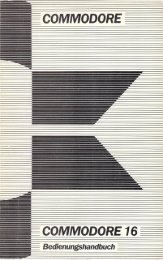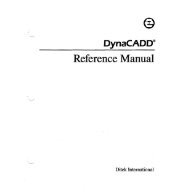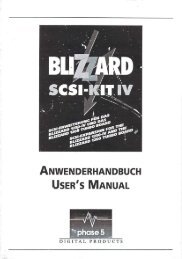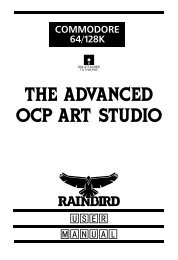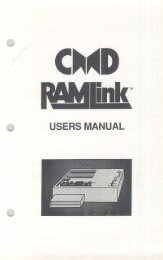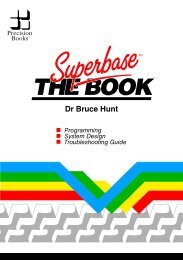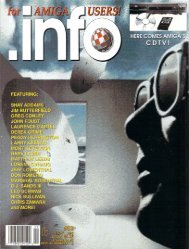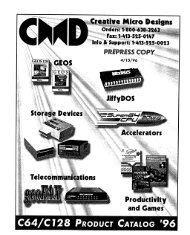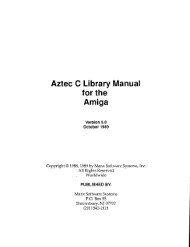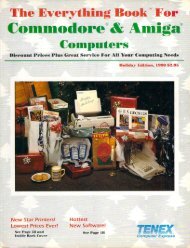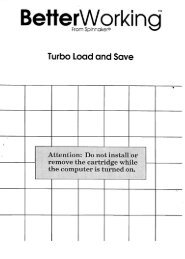You also want an ePaper? Increase the reach of your titles
YUMPU automatically turns print PDFs into web optimized ePapers that Google loves.
mind that per kilobyte of online memory, a hafd<br />
drive is more cost efficient than a floppy. A<br />
10 meg drive for $895 comes to about 9.2 cents<br />
per K (cpK) as compared to the 1541 (84 cpK<br />
at $149) or the SFD-1001 (28 cpK at $299).<br />
COMMENTS<br />
The table presents the major features of the<br />
six different hard drives that should be<br />
available by the end of the year. There may<br />
be other hard drives down the road, too. Both<br />
Commodore and Skyles Electric Works (of<br />
Blitz! and 1541 Flash! fame) have recently<br />
made noises in the hard drive direction. But<br />
for now, this is the selection:<br />
D9060 / D9090. Not designed for the 64 but<br />
works fine using an IEEE interface. These<br />
Commodore drives have been discontinued, but<br />
are built like tanks and can still be found.<br />
Many arc in use in BBS systems. I could have<br />
sworn that I saw in some user group newsletter<br />
that warehoused D9060s were being sold 'as is'<br />
for $295, but several frantic searches through<br />
my meticulously maintained files failed to<br />
turn it up. (I've also been told that the D9090<br />
had some quirks...)<br />
ST10C. From Computer Specialties, Inc.<br />
This drive is the only readily available hard<br />
drive for the 64 as I write, and CSI has just<br />
slashed the price by $600, to $995, no doubt in<br />
response to the burgeoning competition. It has<br />
both serial and IEEE connectors, and one of<br />
the STIOC's nicer features is a built-in backup<br />
routine that saves the files on ST10C to any<br />
disk drive that's connected to it, if you can<br />
stand the many hours required to do so.<br />
JCT-1000 Series. These drives should be on<br />
the market (and discounted) by the time you<br />
read this. I talked to Ray Rippcy, JCT's chief<br />
programmer, and several changes and additions<br />
are in order since the feature pre-rcview of the<br />
JCT-1000 in the September 1986 issue of<br />
COMPUTER SHOPPER. A routine for<br />
handling subdirectories (a hard drive must!) has<br />
been added to the operating system. The JCT's<br />
DOS is all in ROM and the only the Master<br />
Jumptable is loaded into the drive's RAM at<br />
startup. This makes modifying the drive's<br />
routines easy! And a dual 10 meg drive (the<br />
JCT-1021) is in the works and due for release<br />
sometime early next year.<br />
ICT DATA CHIEF. This hard drive is<br />
unique in a number of ways. It comes<br />
equipped with a (very) 1541-compatible floppy<br />
drive. It is factory-formatted into 170K<br />
partitions -- about 60 per each 10 megs - for<br />
I<br />
"■i<br />
i<br />
-<br />
-i<br />
Uiiiiiiiimiuuu. i<br />
-<br />
i<br />
- \<br />
IIIIIHIMII'f111" J<br />
enhanced 1541 compatibility. (A special file<br />
chaining command helps to overcome the 170K<br />
file length limitation.) It has a large case and<br />
powerpack for internal expansion to up to 80<br />
megabytes! And finally, it works with both the<br />
64 CP/M cartridge and the 128's CP/M mode<br />
(as a single-sided Commodore 1541 drive only.)<br />
The one difficulty is the lack of a CP/M<br />
command to switch partitions. Also, a second<br />
serial bus connector required for daisychaining<br />
was missing from the pre-production<br />
model.<br />
The chief advantages of adding<br />
a hard disk drive to a system<br />
are having large amounts of<br />
data online at one time, the<br />
capacity for creating very large<br />
REL and 5EQ data files, and the<br />
potential for greater access speeds.<br />
LT. KERNAL. This is the FAST hard drive<br />
that really started the current hard drive<br />
commotion. Rather than creating a 1541 workalike<br />
hard disk, Fiscal Information designed<br />
the Lt. Kernal to be a true (i.e., very fast) hard<br />
drive that is compatible with the Commodore<br />
64 and its software. The Lt. Kernal's DOS is<br />
currently about 170K long, completely<br />
upgradeable and bank-loads as needed into the<br />
expansion port interface's 16K of RAM.<br />
Besides adding over 40 new or improved<br />
commands to the 64's repertoire, the Lt. Kernal<br />
features an ISEPIC-like utility for installing<br />
protected programs on the hard disk in such a<br />
way that they cannot be off-loaded back to a<br />
floppy disk. What about speed? The early<br />
versions of Lt. Kernal could transfer 25K bytes<br />
(a 100 block program) in about one second, or<br />
about 43 times faster than a 1541. The release<br />
version can load or save about 38K in the same<br />
one second. With a 128 in the fast mode, the<br />
\



